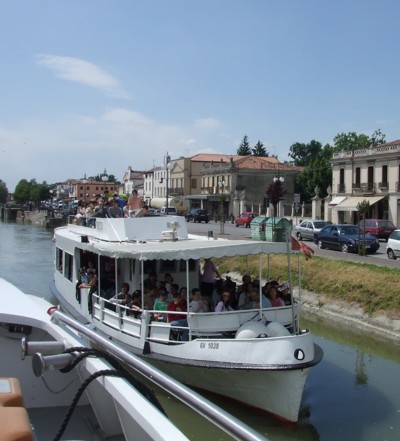A cruise along the Brenta Canal: villas and gardens
When Venice’s sea trade began slackening in the fifteenth century, the city turned its attentions to the mainland Veneto, expanding its holdings inland. Rich Venetian families acquired farmland and began building the villas which can still be admired today. These began as headquarters for overseeing agricultural estates, but soon became used as summer residences; offering rural respite from stuffy Venice. Naturally appearances were important as the nobility wished to entertain and to compete with their neighbours. Architects and artists were brought in to decorate the villas and sometimes – as at the Barchessa Valmarana – former agricultural buildings were converted into luxurious accommodation or ballrooms.
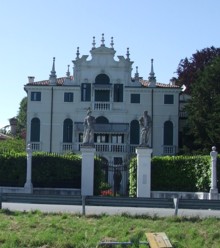
The Naviglio del Brenta, the waterway linking Padua and Venice, was a vital thoroughfare for commerce and for travel. Although commonly described as a canal, this calm stretch of water has natural origins. The Venetian engineers diverted the main course of the Brenta to the south of the lagoon, to prevent their city from silting up. This branch of the Brenta was developed into a managed waterway governed by locks. Public transport along the Brenta was by the original burchiello, a type of luxurious barge, pulled by horses. Nowadays a few motorised vessels perform the same service for leisurely tourist trips.
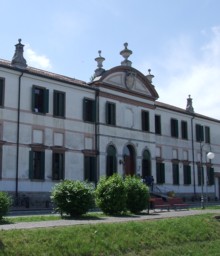
Today the area is less rural; little towns have grown up around the villas, many of which have grown scruffy with age and neglect. A few are partially spruced-up and open to the public; others are hotels or elegant private residences; many moulder alongside their ruined stables.
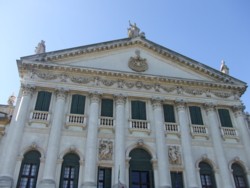
If you have money and time to spare, you can spend an entire day on a cruise along the Riviera del Brenta, visiting villas on the way. Several companies run almost identical itineraries, with one-day cruises running from Venice to Padua or Strà and vice versa. There are also various half-day options. The landscape is flat, and the route runs alongside roads and through built-up areas, but it’s an interesting journey offering leisurely views of the villas along the Brenta.
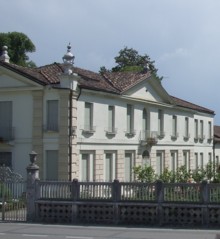
Buses between Venice and Padua run much of the same route, so it is possible to visit the villas more cheaply in your own time. Catch the ACTV service 53E from Piazzale Roma in Venice, or Piazzale Boschetti in Padua. If you only have time for one villa, the Villa Pisani is by far the largest and grandest.
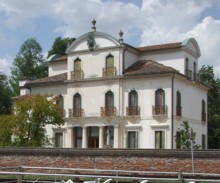
Cruise details
The Burchiello offers full and half-day trips – check the latest prices and timings online and note whether your ticket includes admission to villas and the return trip by bus. You can book in advance online or over the telephone. If you haven’t booked you could still try turning up on the day to see if there are any places. The optional restaurant lunch costs extra. On our trip there were a small bar and toilets onboard, and lots of comfortable seating indoors. The top deck is open to the elements (take suncream), and its wooden benches can get crowded. The guides provide commentary in several languages including English, and usher visitors around the villas. We’ve taken a trip on the boat, and our review can be read below.
The Battelli del Brenta, another firm which runs Brenta cruises, offers slightly longer trips, running into Padua. They don’t include return travel in their prices.
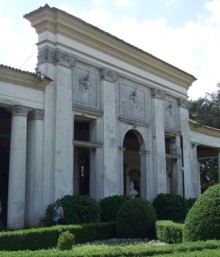
Villa Foscari
Villa Foscari, known as La Malcontenta, is the most famous villa on the Brenta. It’s the closest to the Venetian lagoon, and sits on a picturesque bend in the waterway, framed by weeping willows. The building was designed by Andrea Palladio for the Venetian Foscari family in the mid sixteenth century, and was a showcase for his influential architectural theories. The villa’s nickname, La Malcontenta, is said to come from a miserable Foscari wife who was exiled here.
The reception floor, the piano nobile, is open to the public, and consists of a few lofty frescoed rooms, where architectural decoration is painted rather than real. The villa was used as a military hospital during the Austrian occupation, during which time it was damaged, whitewashed and the chapel was destroyed. Since then the house has been restored and furnished by more sympathetic owners, and it is currently home once more to Foscari descendants, who have living quarters on the floors not open to the public.
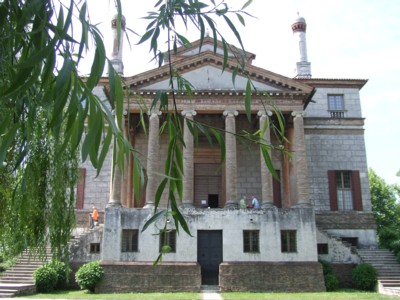
Oriago
Lunch for the Burchiello passengers is taken at a restaurant in Oriago. It’s not included in the basic tour price, but is an additional set charge, with a choice of either a fish or a meat set menu. If you prefer to save money, you can take a picnic to eat on the boat or along the river. A little way back along the canal is Oriago’s market, where there is a little bakery (which closes at 1pm for lunch) where you can buy mini pizzas, pastries and bottled water. A cluster of shady benches by the canal makes a nice place to sit.
Barchessa Valmarana
Some boat tours visit the Barchessa Valmarana, others moor at the Villa Widmann, opposite. The actual Villa Valmarana was destroyed a century ago (to avoid taxes, according to our guide), but its two wings (barchesse) are left standing, and one can be visited. These barchesse are a feature of villas in the Veneto: long porticoed buildings alongside the main villa which were originally intended for agricultural use. In the Barchessa Valmarana there are several rooms to visit, including a ballroom in a converted granary with welcoming frescoes. The gardens and portico are also worth wandering.
Villa Pisani, Strà
This massive and grandiose palace is the final stop for Burchiello passengers. Built in the first half of the eighteenth century, it boasts 114 rooms, to celebrate the 114th doge, a Pisani. Highlights of the tour include a glorious ballroom with frescoes exalting the Pisani family, and a grand bed and sunken bath made for Napoleon (who spent one night here and then gave the palace away). It’s hard to do justice to the palace’s extensive gardens when you’re on a tour timetable, but they are worth exploring. The seeming palace at the other end of a lake is in fact a sham, masking stables. There is a maze, an orangery, formal gardens and an ‘English’ wilderness.
> More about the Villa Pisani
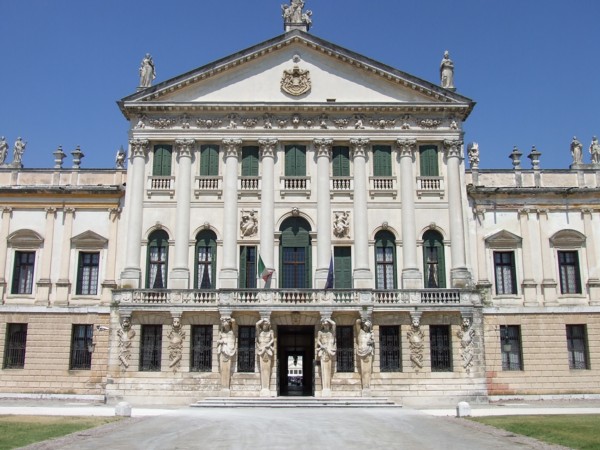
Our Burchiello cruise
We took a day excursion from Venice on the Burchiello, a cruise which is run by the Italian transport company SITA. We booked online and followed this up with another email when we didn’t receive a confirmation. Having received a reply with all the details, we paid by credit card over the phone (this can also be done by fax). Apart from the initial delay, communications were prompt and helpful. Just before 9am our guides Elisa and Raimonda welcomed us, ticked our names on their list, and the boat set off promptly from its dock in Venice, heading along the Giudecca and out over the windy lagoon.
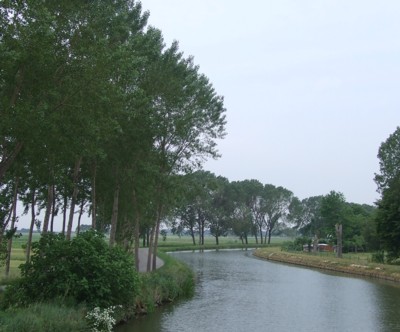
The first stretch of canal, after the entry lock, was surprisingly rural. Flat fields stretched away from the tree-lined shore; a purple heron watched us pass; gun-toting soldiers on an exercise waved at us from their little boats. Later stretches were more built-up and we found them less atmospheric although still interesting. Villas were speckled among more modern developments; in Mira they came so thick and fast that we were turning our heads as though at a tennis match, trying to keep up with our guide’s commentary. Along the route the boat passed through several locks, ascending in height. There were also a number of bridges which need to be lifted or swivelled out of the way; a two-man team turned up in a car to open them for us. There was also a moment of excitement when we passed under a bridge so low that we were sent downstairs while a crew member lowered the boat’s railings.
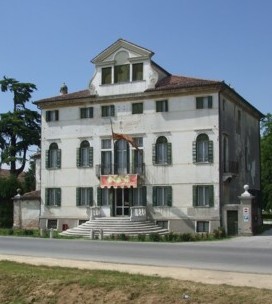
Our first stop was the Villa Foscari, where a large group of Italians from Trieste joined our party. Our guide Elisa, who dealt with the English-speaking and Italian contingents proved very skilled at juggling her unbalanced tasks (four of us, many of them) despite the restricted time in the villas, giving both groups fluent and knowledgeable descriptions (the other guide was managing French and German). After a free aperitivo on board we stopped for lunch at Oriago – we can’t report on the restaurant since we picnicked, but the other travellers seemed satisfied. Then we cruised onwards a short distance to the Barchessa Valmarana. A young boy held the gates open and we entered to explore the pretty gardens and decorated interior.
Our last port of call was Villa Pisani in Strà, where we marvelled at the impressive panorama as we queued to enter. This took a while; the numbers of visitors entering at one time is restricted. Again Elisa led us on a bilingual guided tour around the state rooms, something that we’d normally avoid, but in this case it really did add to our appreciation of what we saw. Among other facts, she pointed out that these villas do not normally have fireplaces (we hadn’t noticed), as they were intended for summer use only. We had been given an appointment for our bus back to Venice, and we were sorry not to have longer in the gardens of the villa. After seeing us into our sleek SITA minibus, Elisa bid us farewell and we headed back to Venice, a surprisingly quick journey after our meandering water-borne progress during the day.
Our excursion wasn’t a cheap day out, but it was scenic and interesting as well as (if you like boats) being a lot of fun. We were extremely impressed with the efficiency, charm and language skills of our guides.
On this site
Useful external links
Veneto destinations
- Veneto region
- Abano Terme
- Asolo
- Bassano del Grappa
- Brenta Canal
- Caorle
- Castelfranco Veneto
- Chioggia
- Cittadella
- Concordia Sagittaria
- Conegliano
- Cortina d’Ampezzo
- Lido di Jesolo
- Malcesine
- Marostica
- Monselice
- Montegrotto Terme
- Padua
- Portogruaro
- Rovigo
- Sottomarina
- Treviso
- Venetian Lagoon
- Venice
- Verona
- Vicenza
- Veneto art & architecture itinerary
- Veneto villas – Vicenza: La Rotonda & Villa Valmarana ai Nani
- Veneto villas – Villa Pisani & Villa Foscarini Rossi, Strà
- Venice Airport
- Treviso Airport
